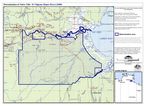 Print this page Print this page | ||
Wandarang, Alawa, Marra and Ngalakan Peoples v Northern Territory [2004] FCAFC 187 | ||
| Category: | Case Law | |
| Binomial Name: | Federal Court of Australia | |
| Date: | 14 November 2000 | |
| Sub Category: | Litigated Determination | |
| Place: | ||
| Click this link to search this location with google maps | ||
| State/Country: | Northern Territory, Australia | |
| Click this link to search this location with google maps | ||
| Legal Status: | Registered on the National Native Title Register. | |
| Legal Reference: | Federal Court file no: NTD6001/97; Tribunal file n | |
| Alternative Names: | ||
| Summary Information: | ||
| Wandarang, Alawa, Marra and Ngalakan Peoples v Northern Territory [2004] 187 FCAFC Between: Wandarang, Alawa, Marra and Ngalakan Peoples (APPLICANTS) AND Northern Territory of Australia, Northern Territory Land Corporation and Northern Territory Seafood Council Inc (RESPONDENTS) Judge: Olney J Determination: Native title exists in parts of the determination area. | ||
| Detailed Information: | ||
| This determination arose from an application for determination of native title originally made to the National Native Title Tribunal in September 1994, and accepted in amended form in December of the same year. The application was made on behalf of the Wandarang, Marra, Alawa and Ngalakan Peoples by Angelina George, Roy Golokurndu, Roy Hammer, Andrew Joshua, John Joshua, Ruth Joshua Maurice Lansen, Jack Riley and Eva Rogers. Andrew Joshua was replaced by Fred Conway upon his death. The trial commenced in Darwin in September 1999. Evidence was heard at several places on or closely adjacent to the claim area. Final submissions were made in Darwin in May 2000. The Court held that native title rights and interests exist in parts of the determination area. This excluded land and waters delineated as roads and the stock route area. Nor were native title rights and interests held to exist in relation to minerals and petroleum. Nor was native title held to exist in relation to the waters segments of the Roper, Limen Bight and Cox Rivers which are affected by the tide. Non-exclusive native title was found to exist however, in relation to the balance of the claim area. The common law holders of native title were determined to be: '(i) are members of one or more of the 12 claimant groups by virtue of descent through his or her father's father, father's mother, mother's father or mother's mother; or (ii) are otherwise recognised as members of one or more of the 12 claimant groups in accordance with the traditional laws and customs of such groups; and are recognised by the Mingirringi, Junggayi and Darlnyin of the countries comprising the determination area as having communal, group or individual rights and interests in relation to the determination area or a part of it.' (see para [140]). The nature and extent of the native title rights and interests in relation to the determination area are: '(i) a right to possess, occupy, use and enjoy the determination area; (ii) a right to speak for and make decisions about the use and enjoyment of the determination area; (iii) a right of reside upon and otherwise to have access to the determination area; (iv) a right to use and enjoy the natural resources found on or within the determination area; (v) a right to maintain and protect places of importance under traditional laws, customs and practices in that area. j) The nature and extent of other interests in relation to the determination area are such rights and interests validly granted by the Crown pursuant to statute or by any valid executive or legislative act affecting the native title of the common law holders including the rights of the registered proprietor of CLP 346 and the rights and interests of members of the public to the use and enjoyment of the determination area according to law.' (see para [140]). Other non native title rights also exist in relation to the determination area. These include such rights and interests validly granted by the Crown pursuant to statute or by executive or legislative act, and the rights and interests of the public in the use and enjoyment of the determination area according to law. The relationship between the native title and non native title rights is that the former must yield to the other rights identified, where their enjoyment is inconsistent. The Court also made reference to the extinguishment of native title in those parts of the determination area where public works may have been established or constructed. The reasons for the decision are set out in Wandarang, Alawa, Marra and Ngalakan Peoples v Northern Territory [2000] FCA 923 (25 July 2000). | ||
Related Entries |
| Organisation |
| Legislation |
| People |
References |
| Case Law |
| Federal Court of Australia (2000) Wandarang, Alawa, Marra and Ngalakan Peoples v Northern Territory [2000] FCA 923 |
| Resource |
| National Native Title Tribunal Native Title Determinations by Litigated Determinations |
Documents |
 Wandarang, Alawa, Marra and Ngalakan Peoples v Northern Territory (Unreported FCA, 14 November 2000) Map - ( Image | Thumbnail | PDF) Wandarang, Alawa, Marra and Ngalakan Peoples v Northern Territory (Unreported FCA, 14 November 2000) Map - ( Image | Thumbnail | PDF) |
 |
Glossary |
| Native Title (Australia) | Litigated Determination (Native Title Act 1993 (Cth)) (Australia) |
| ||||
| ||||
|
Was this useful? Click here to fill in the ATNS survey
